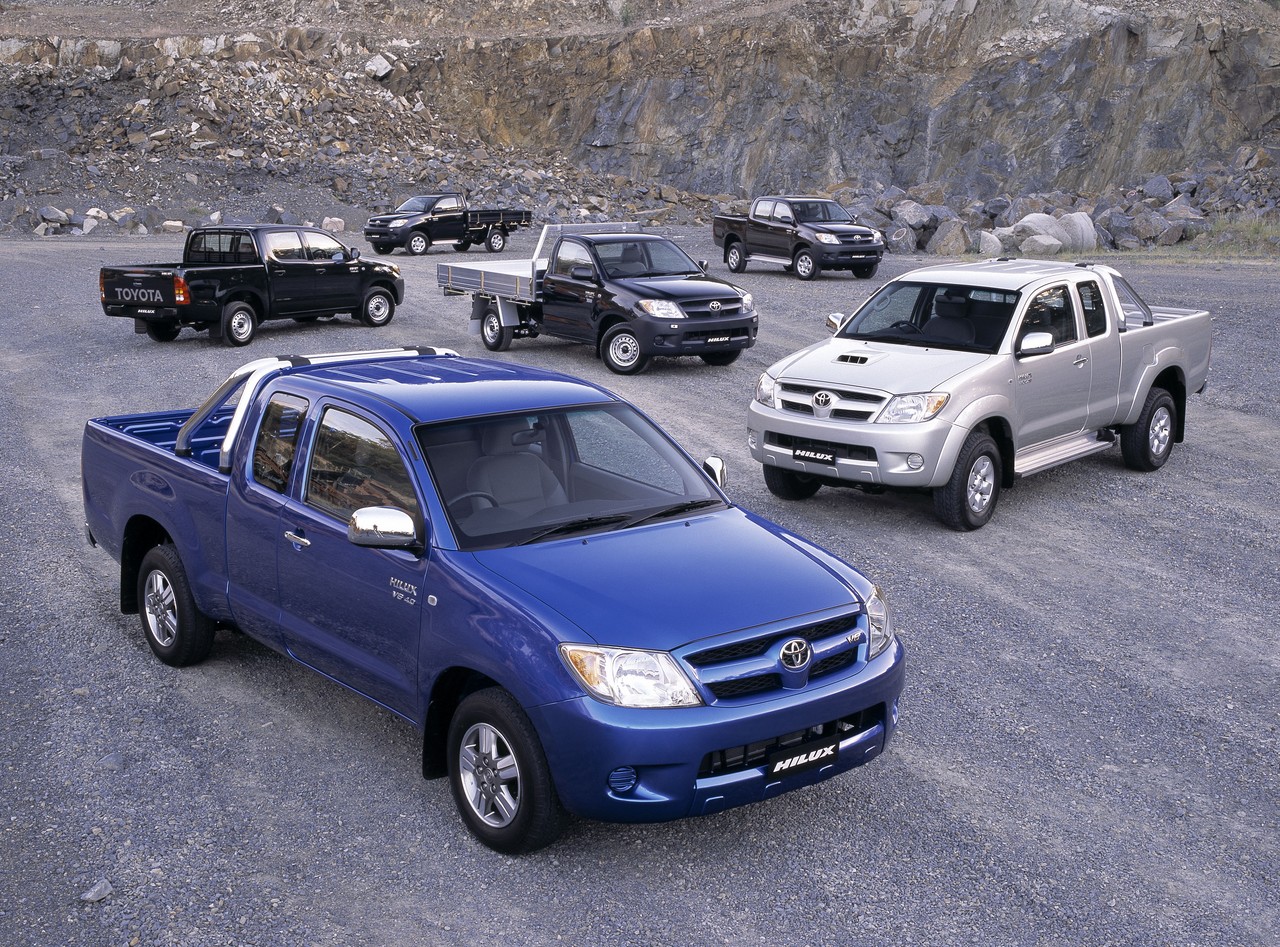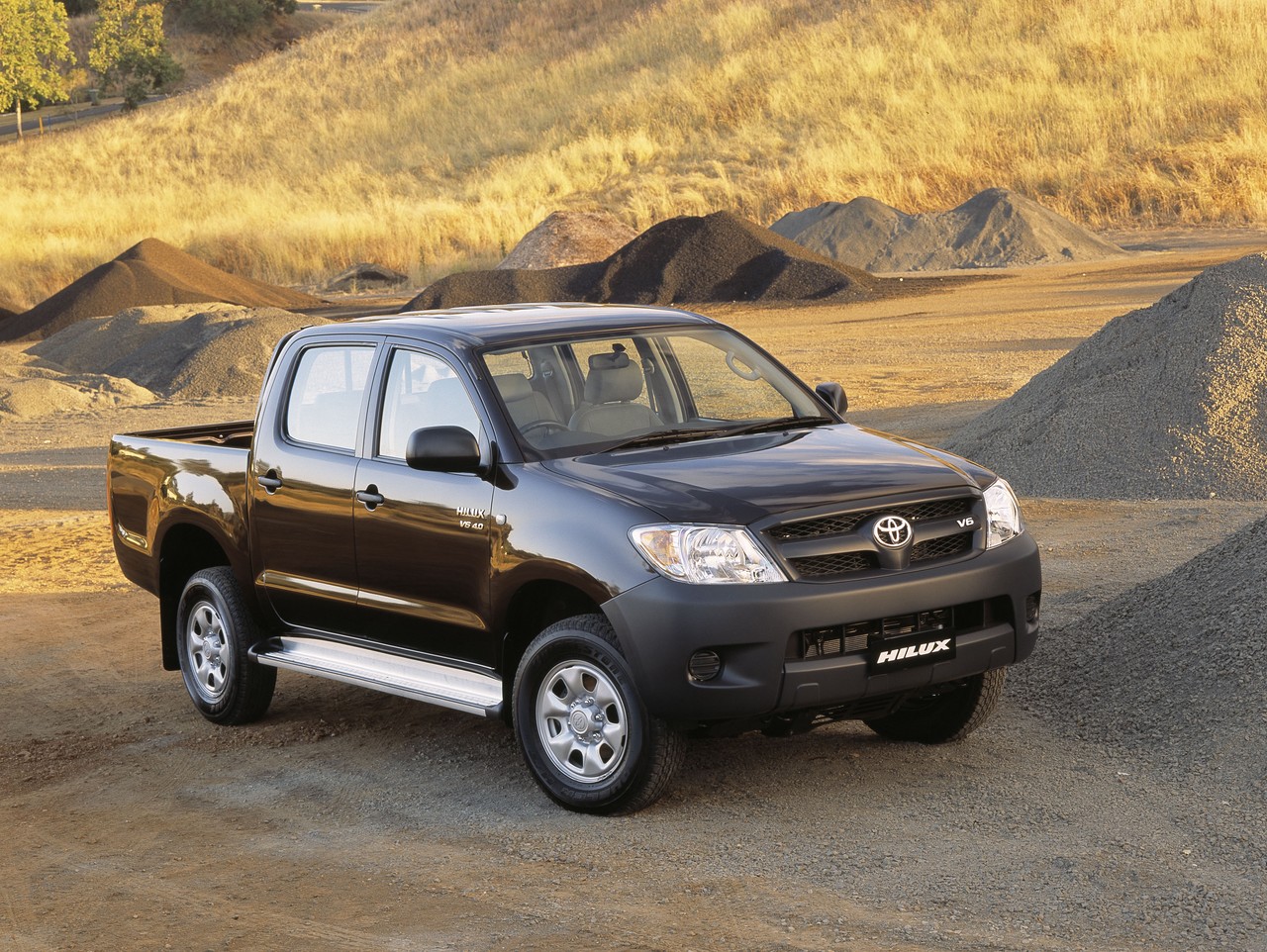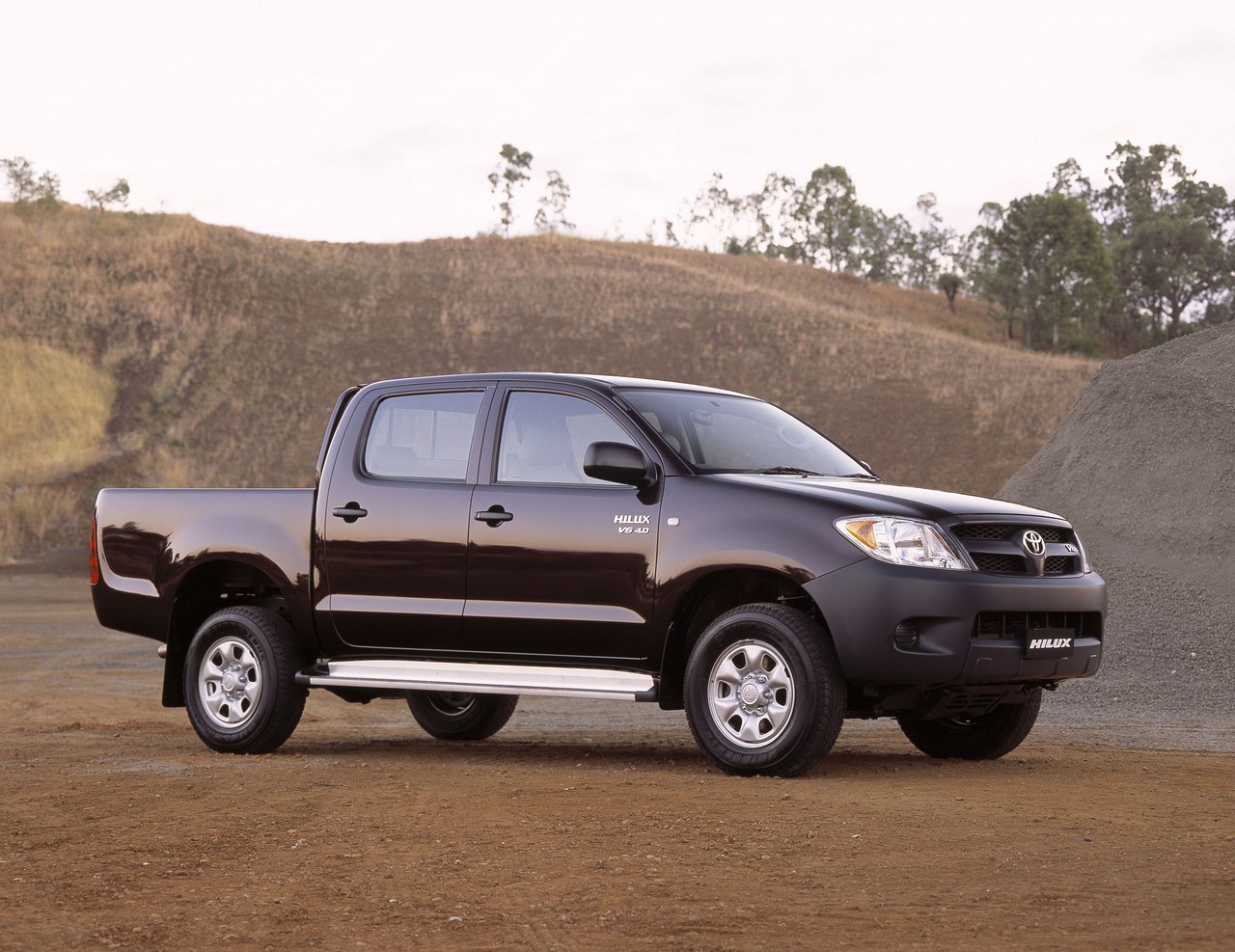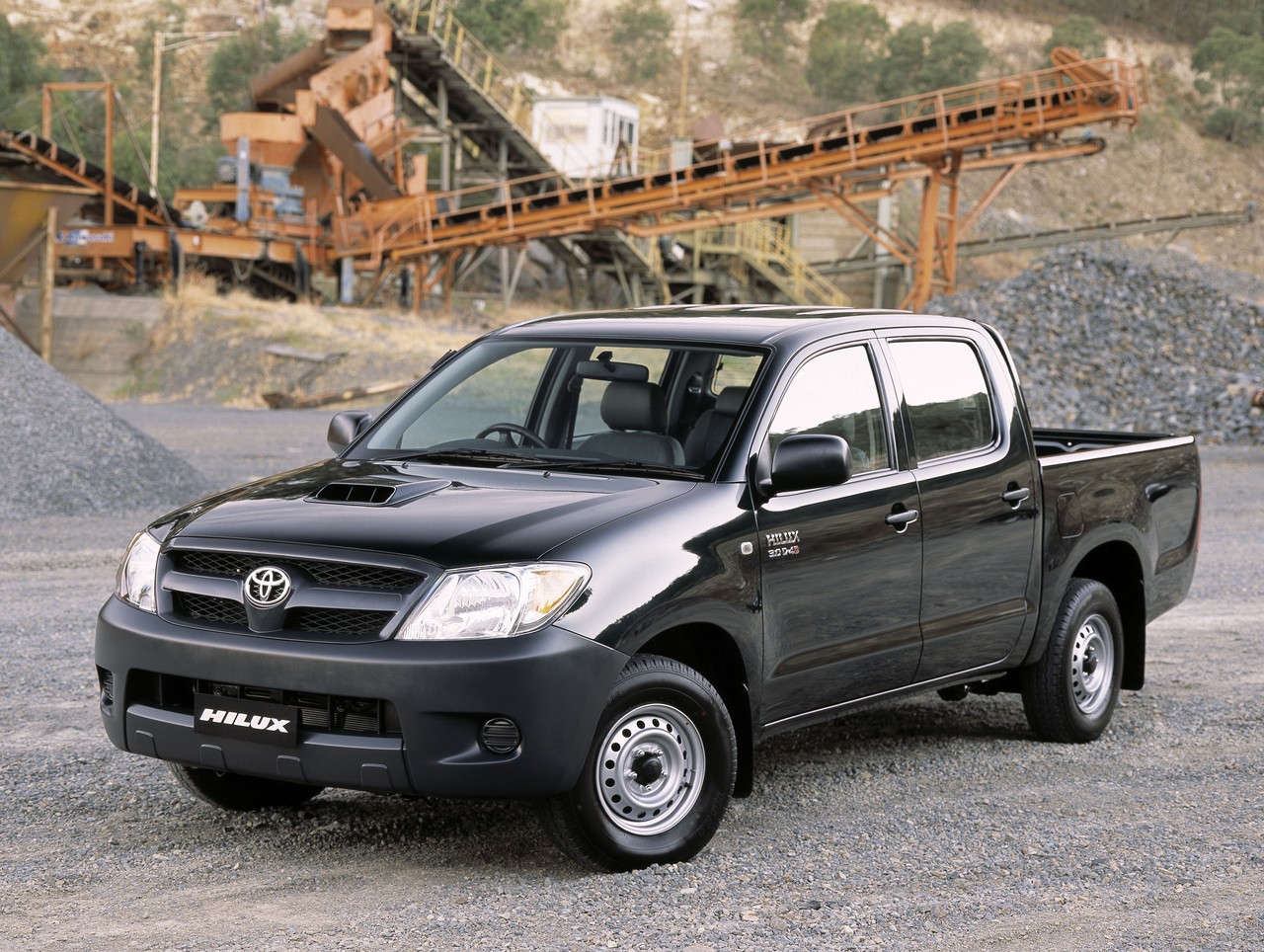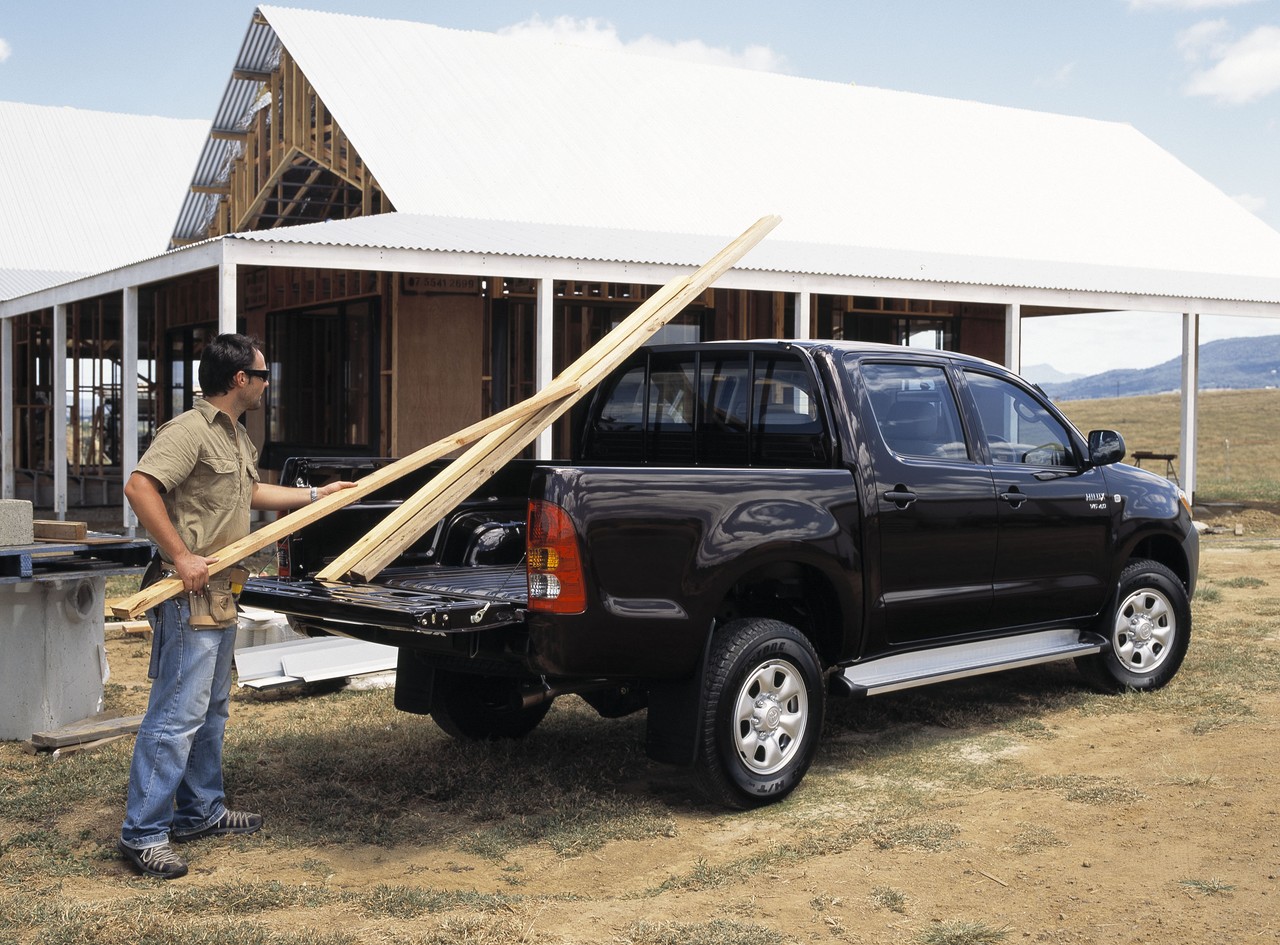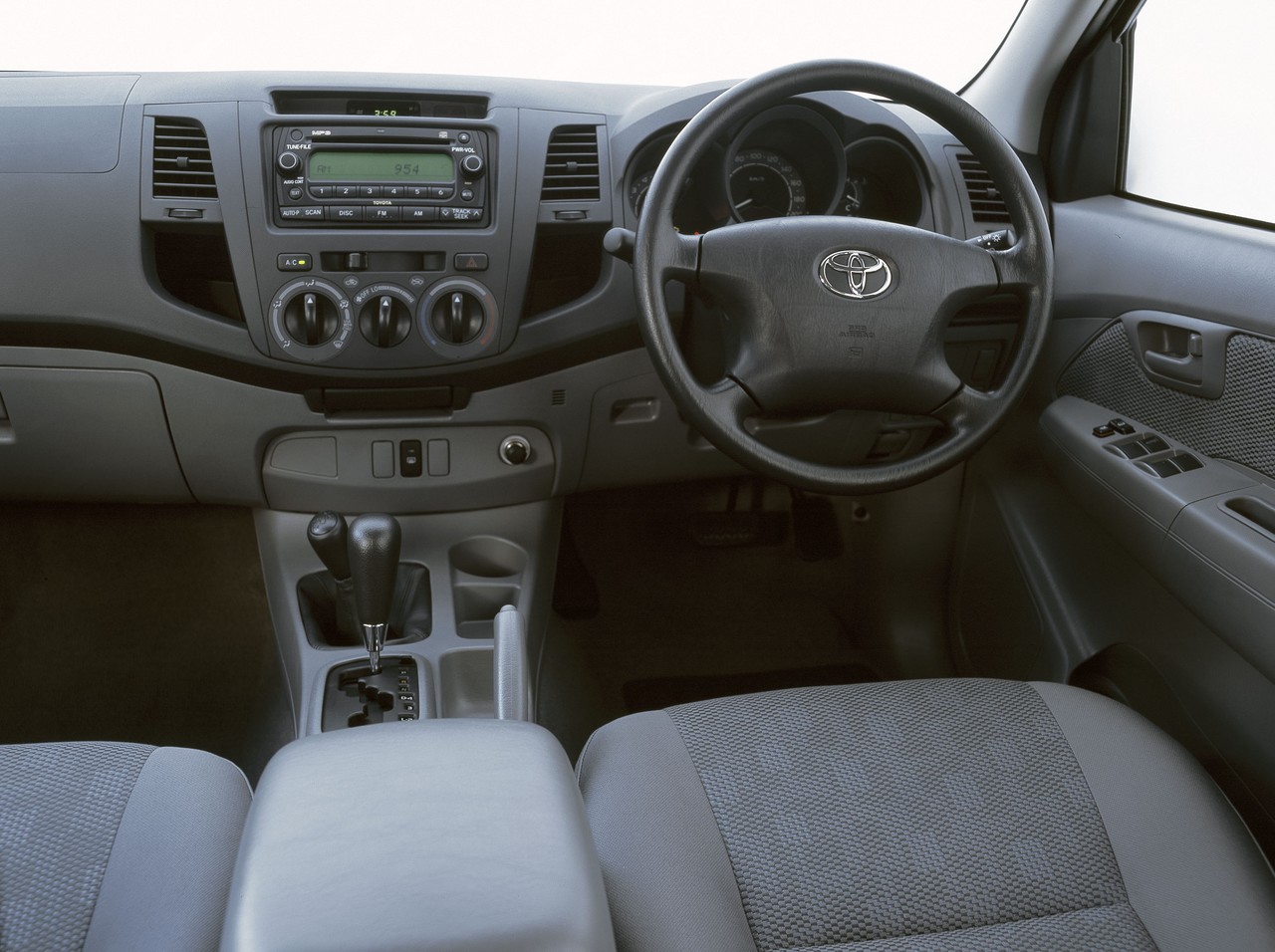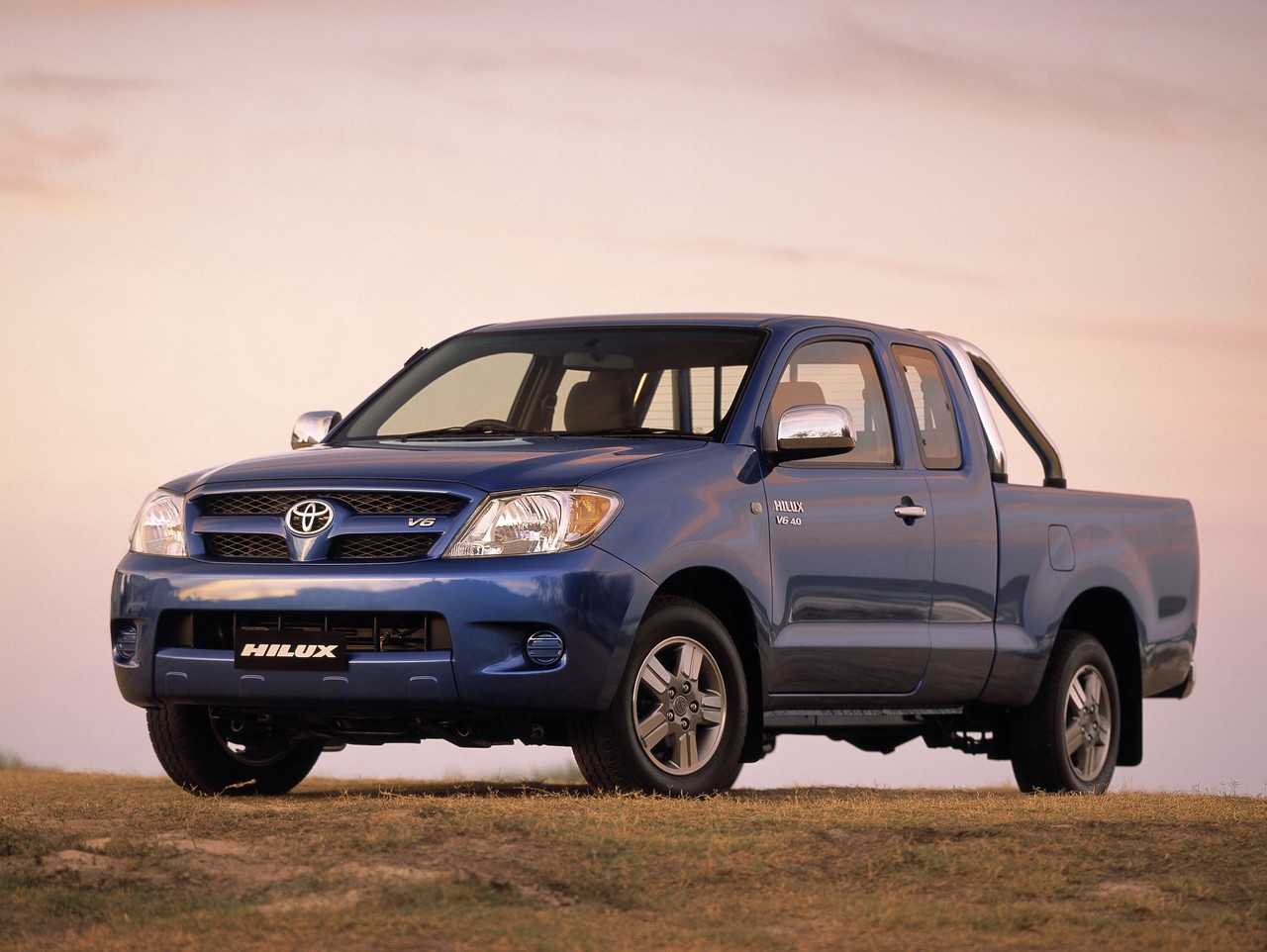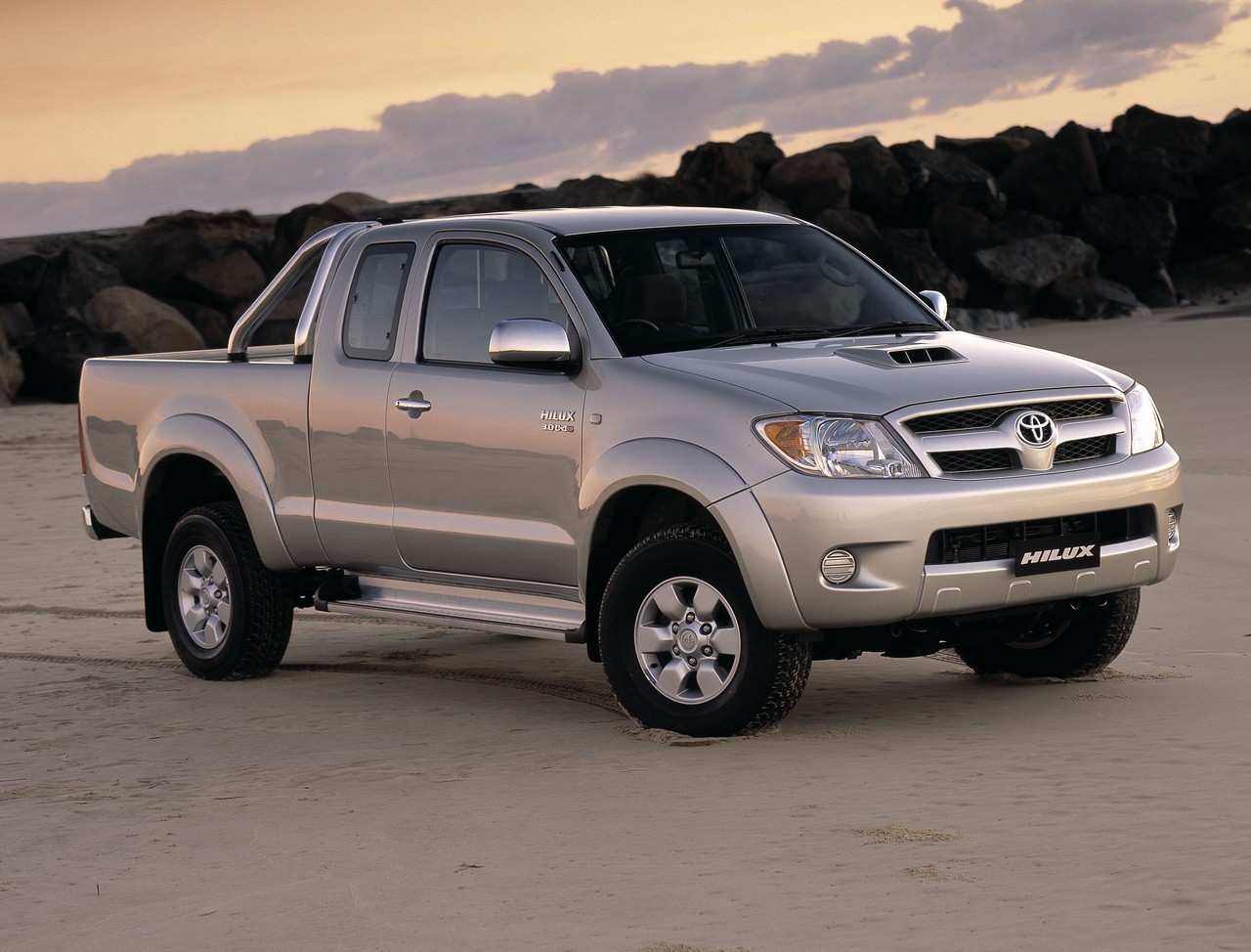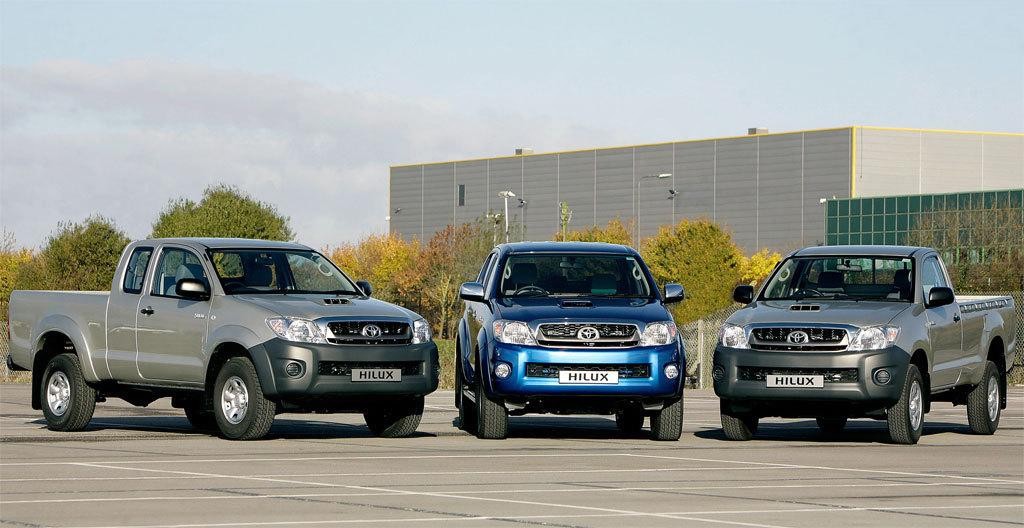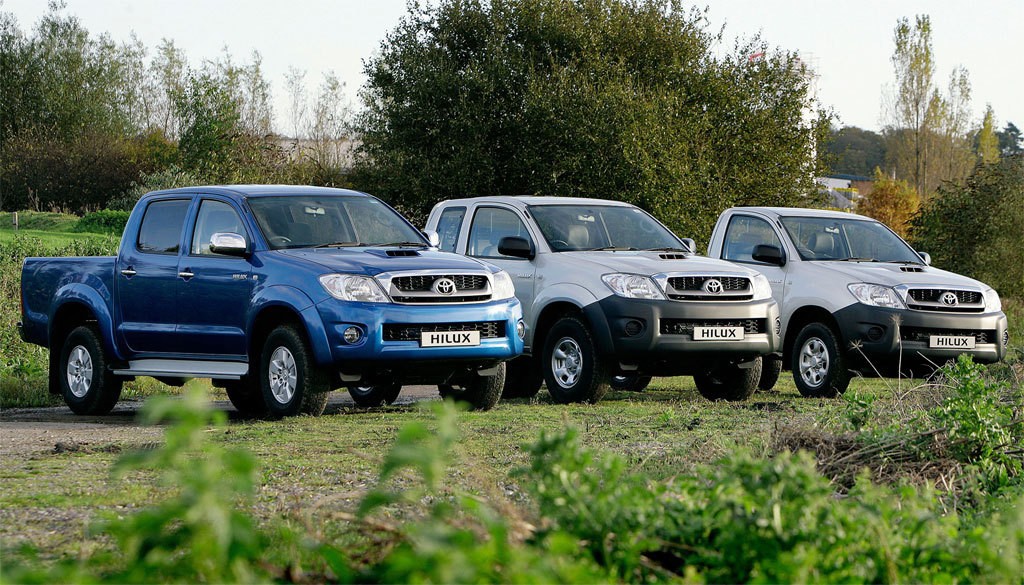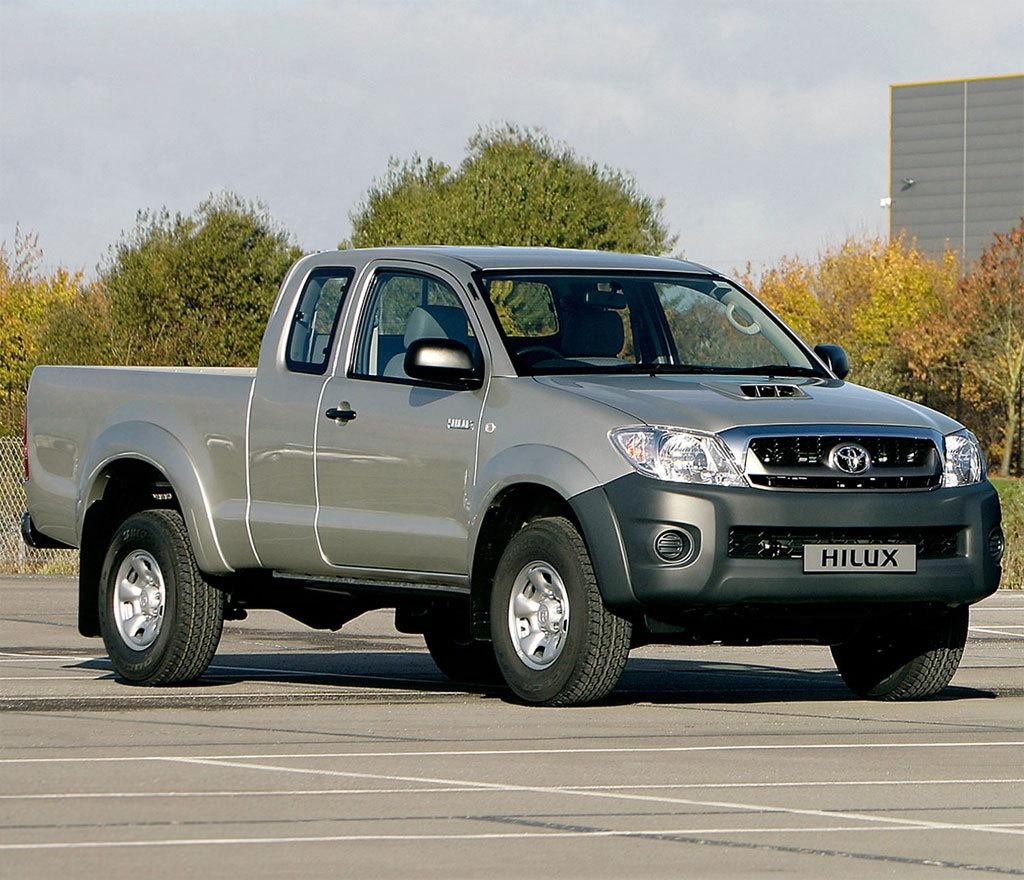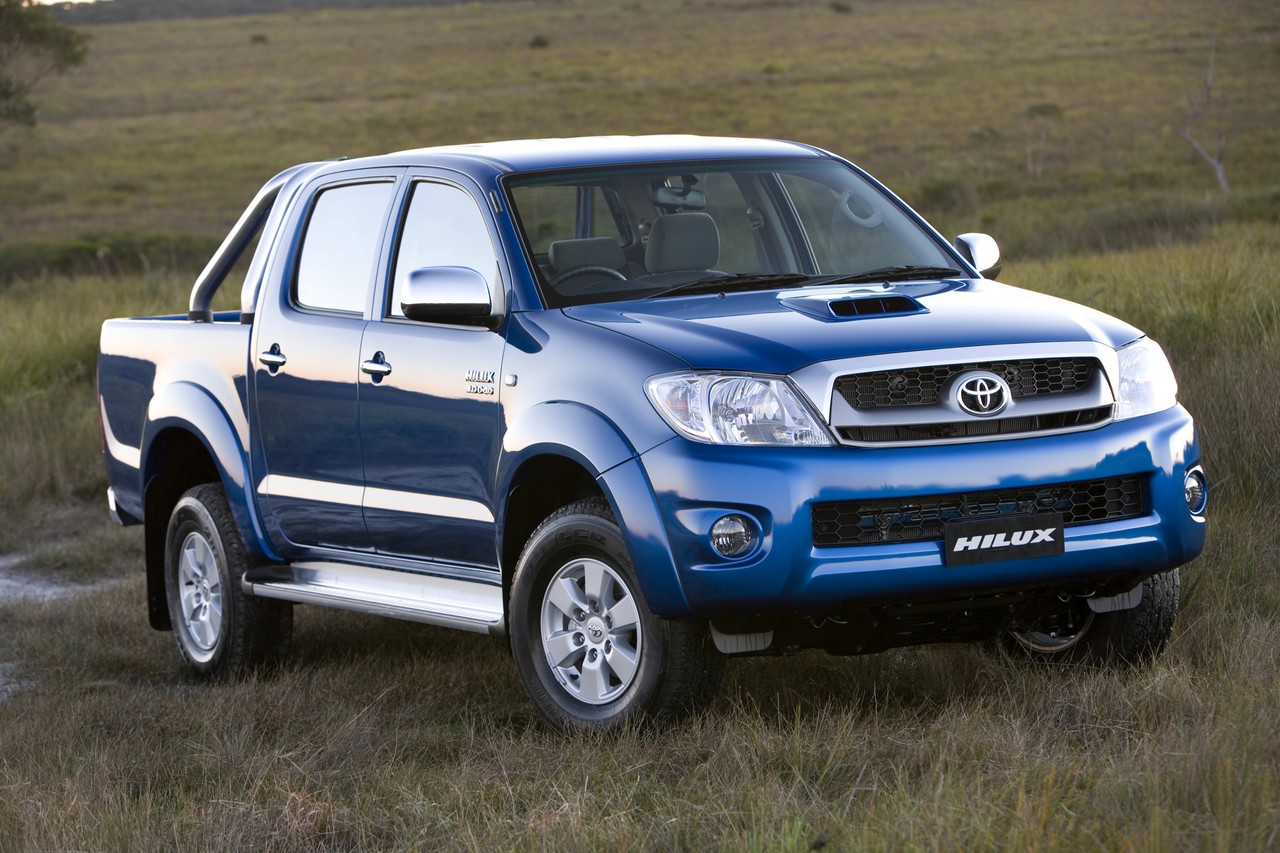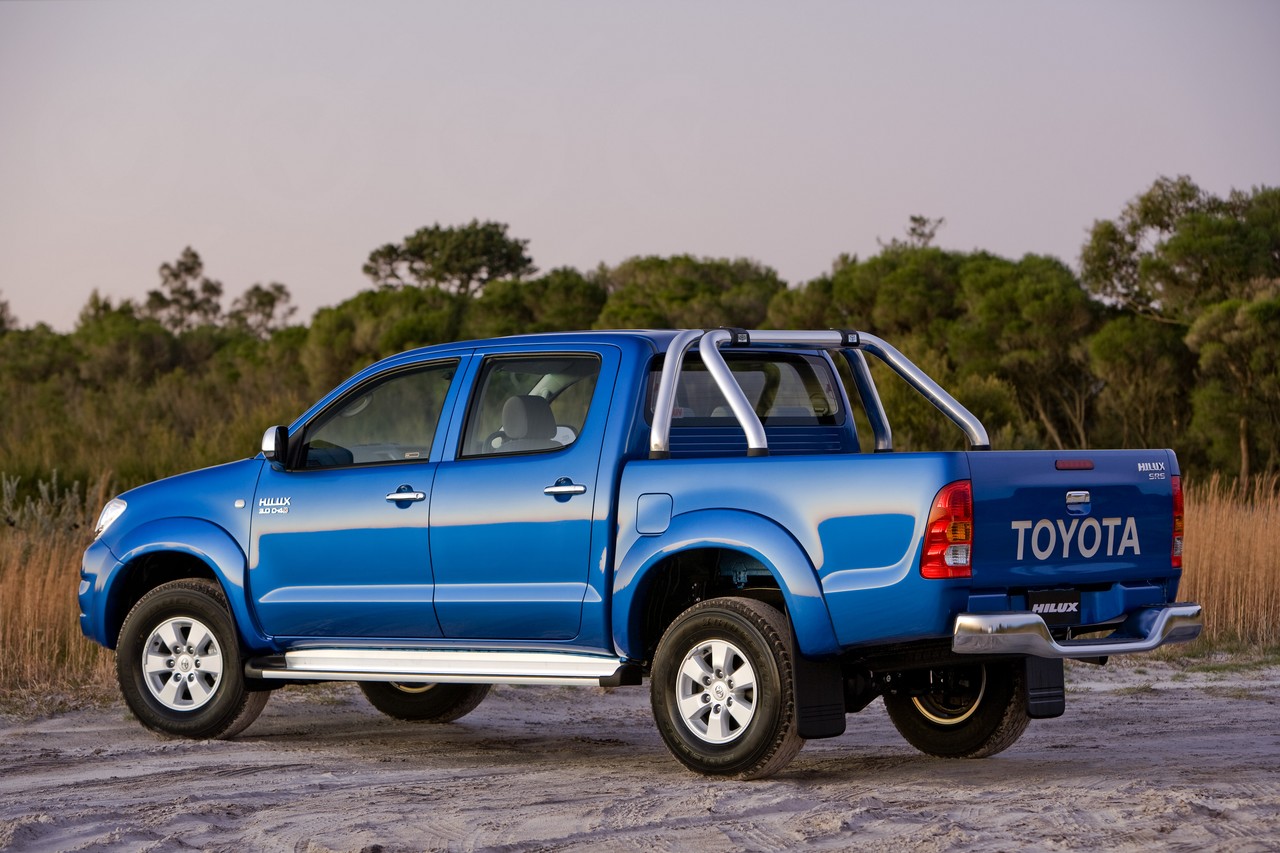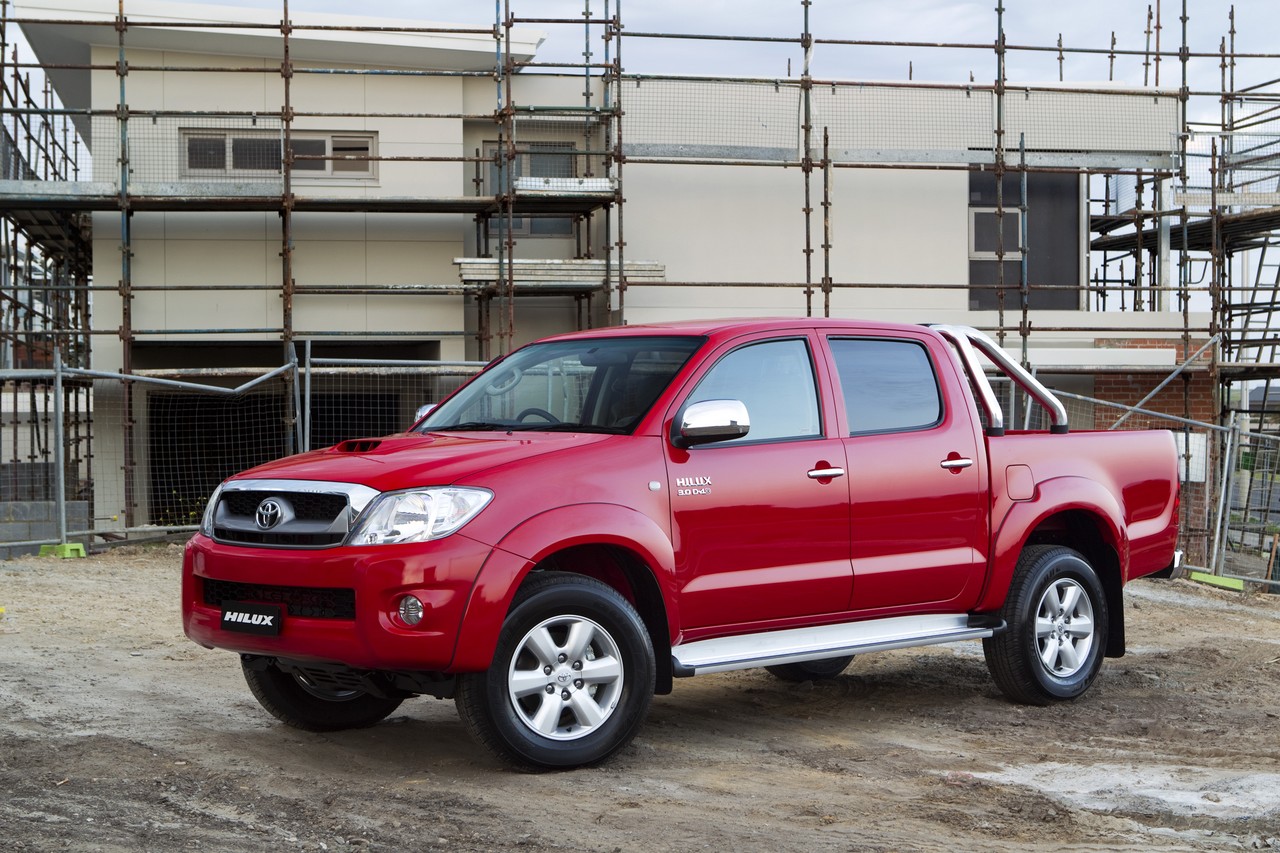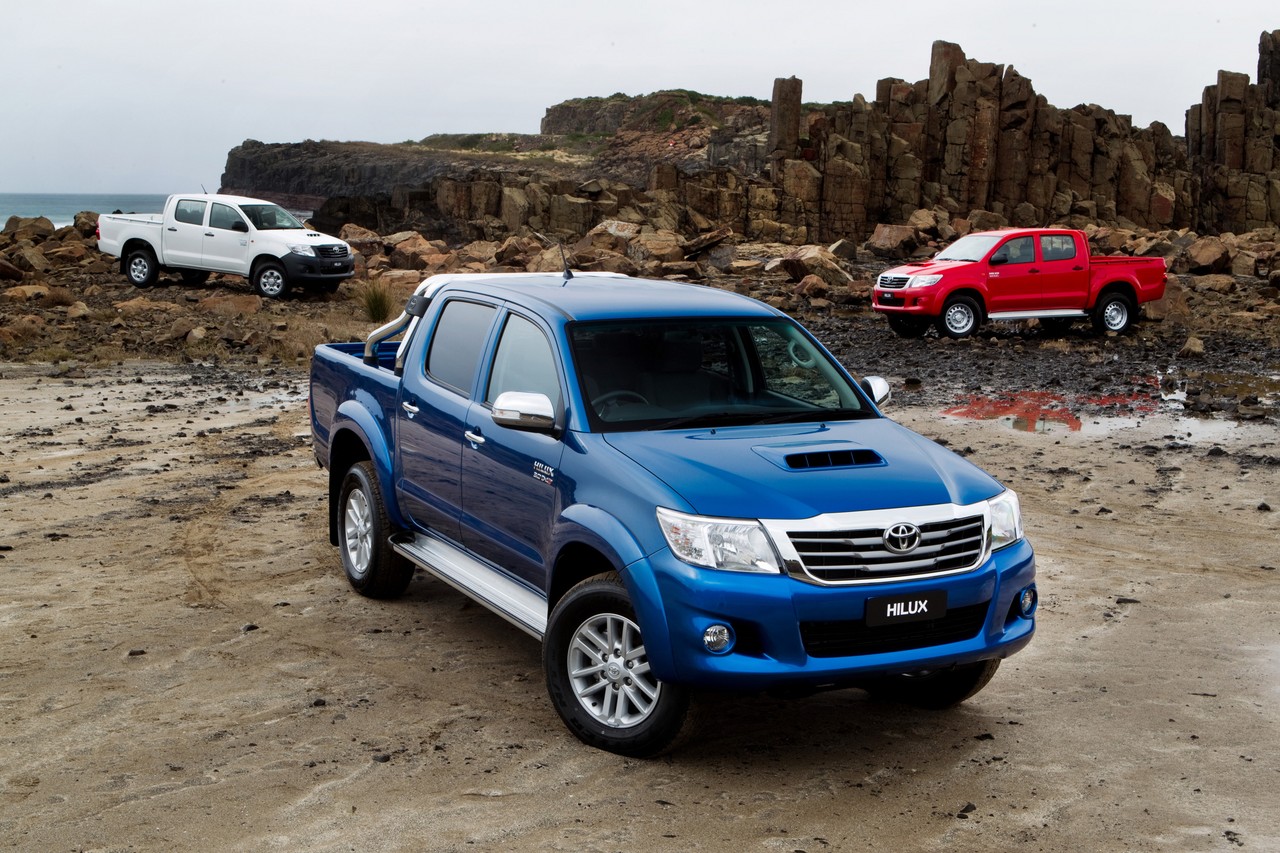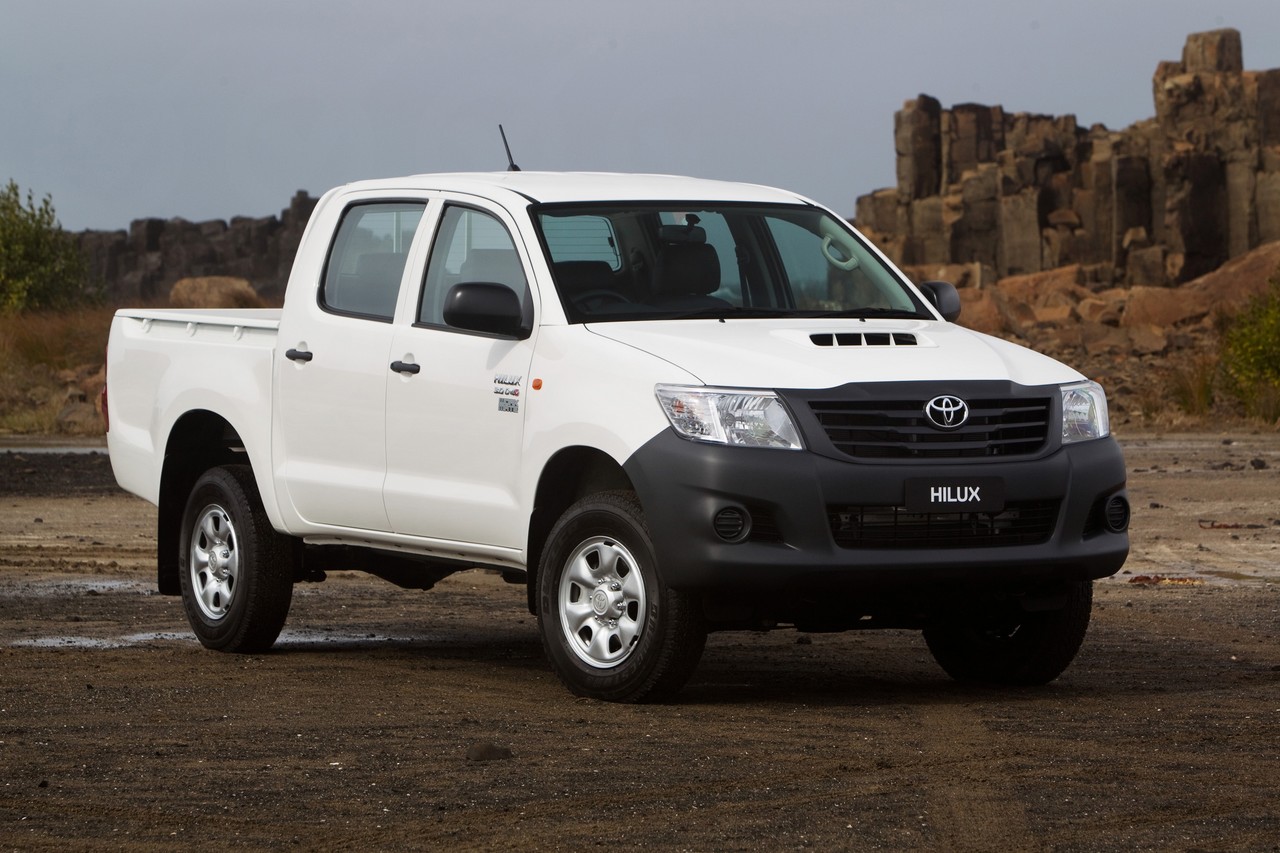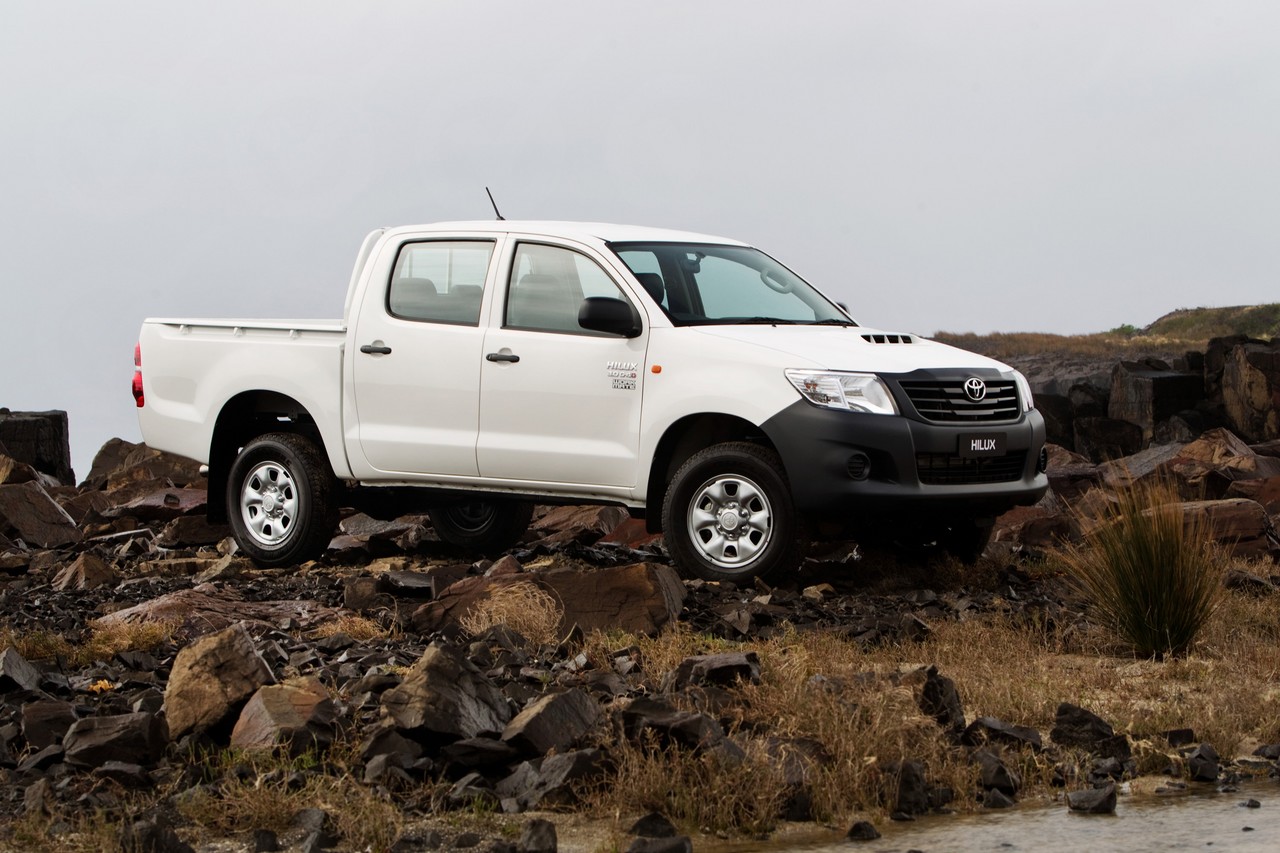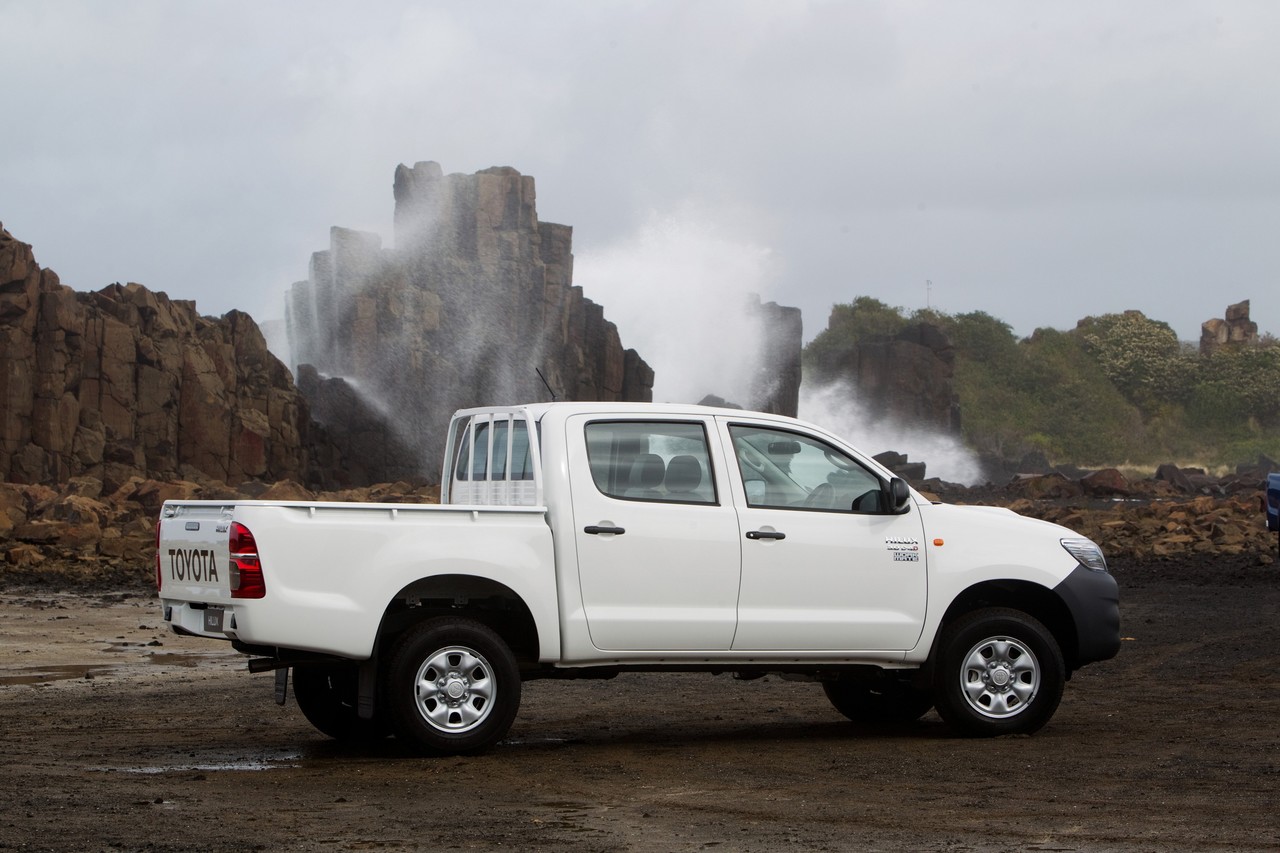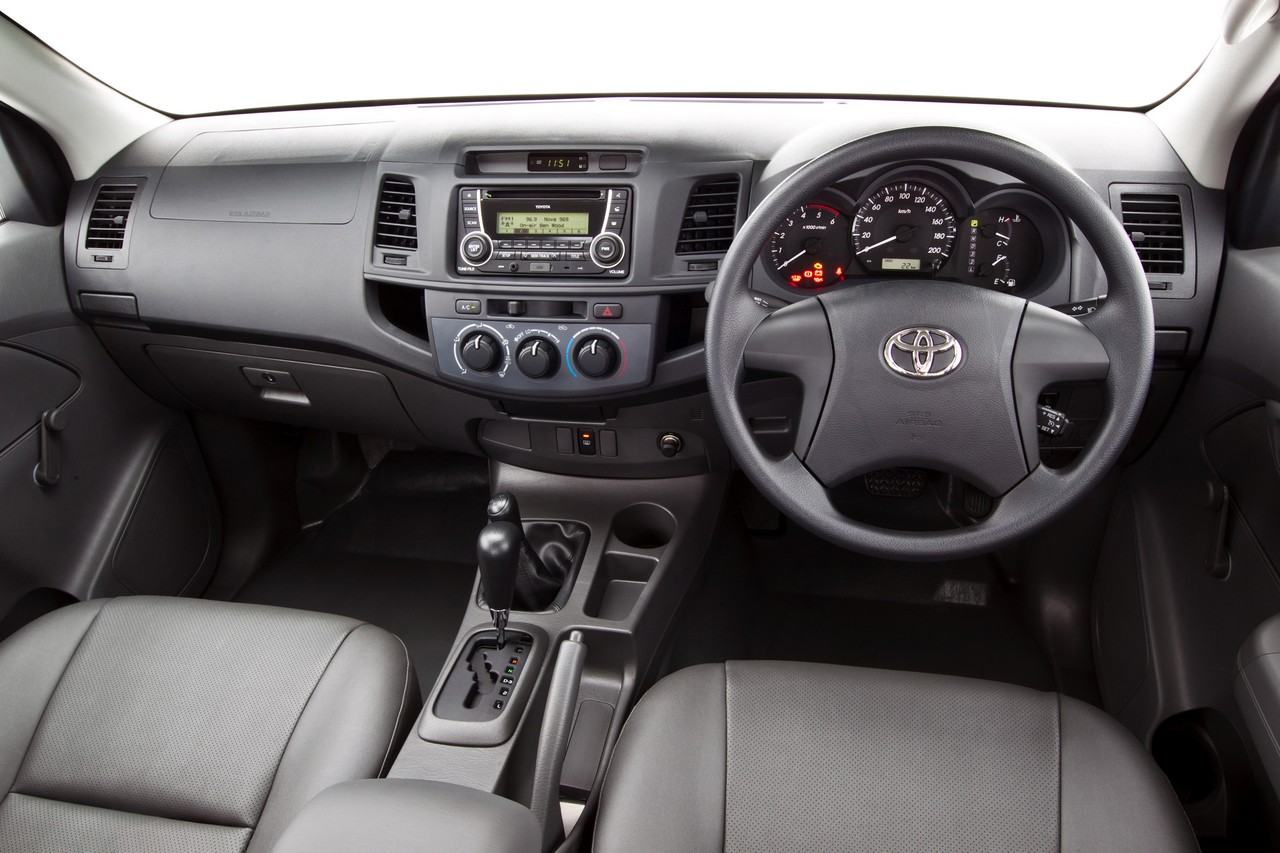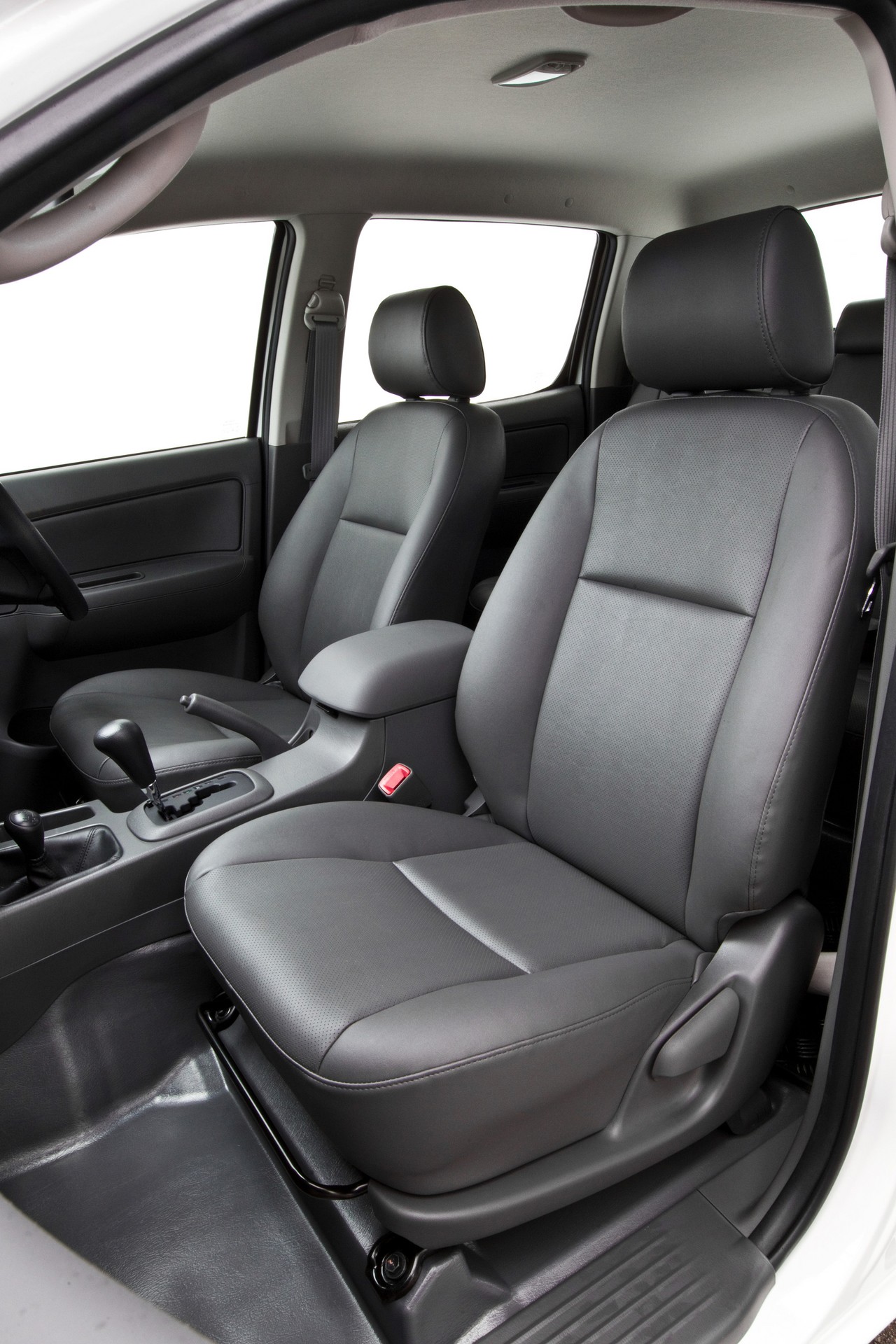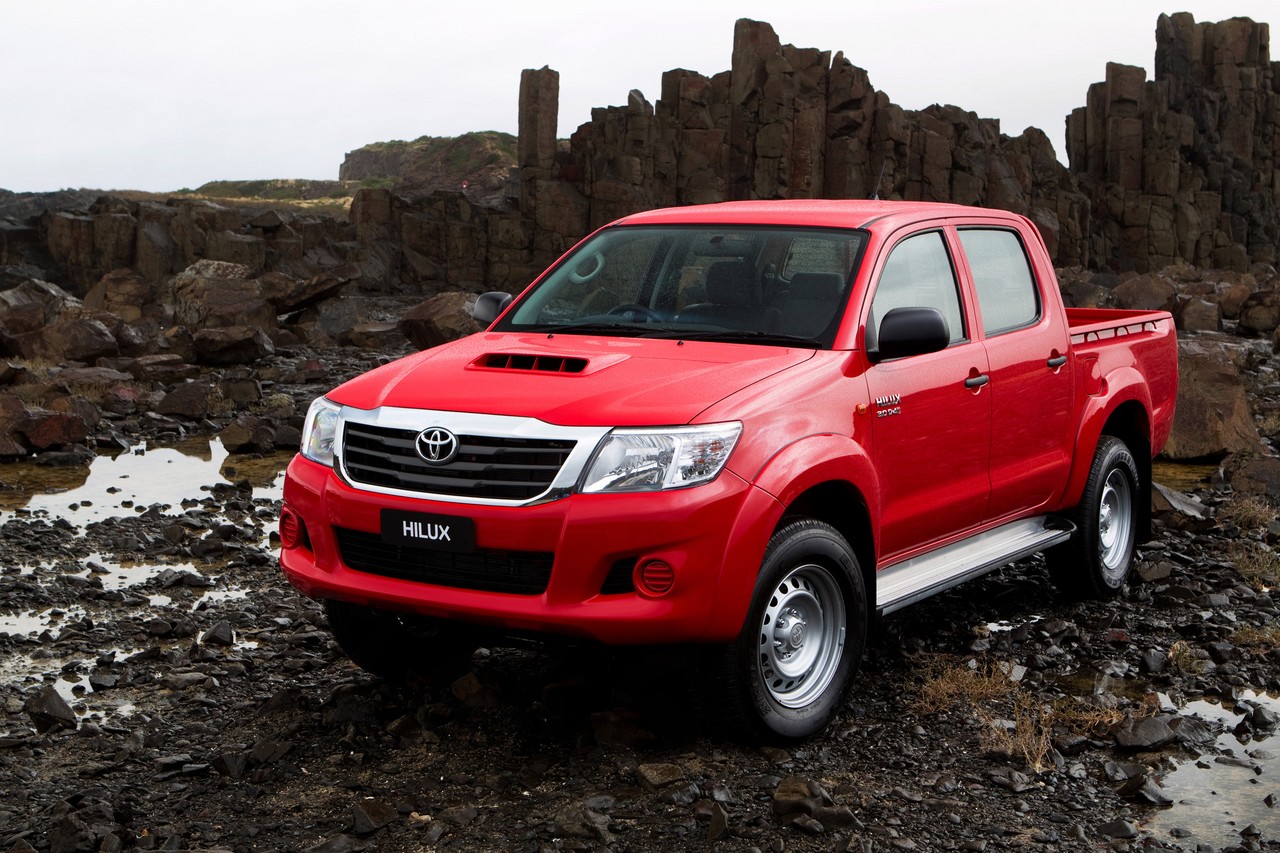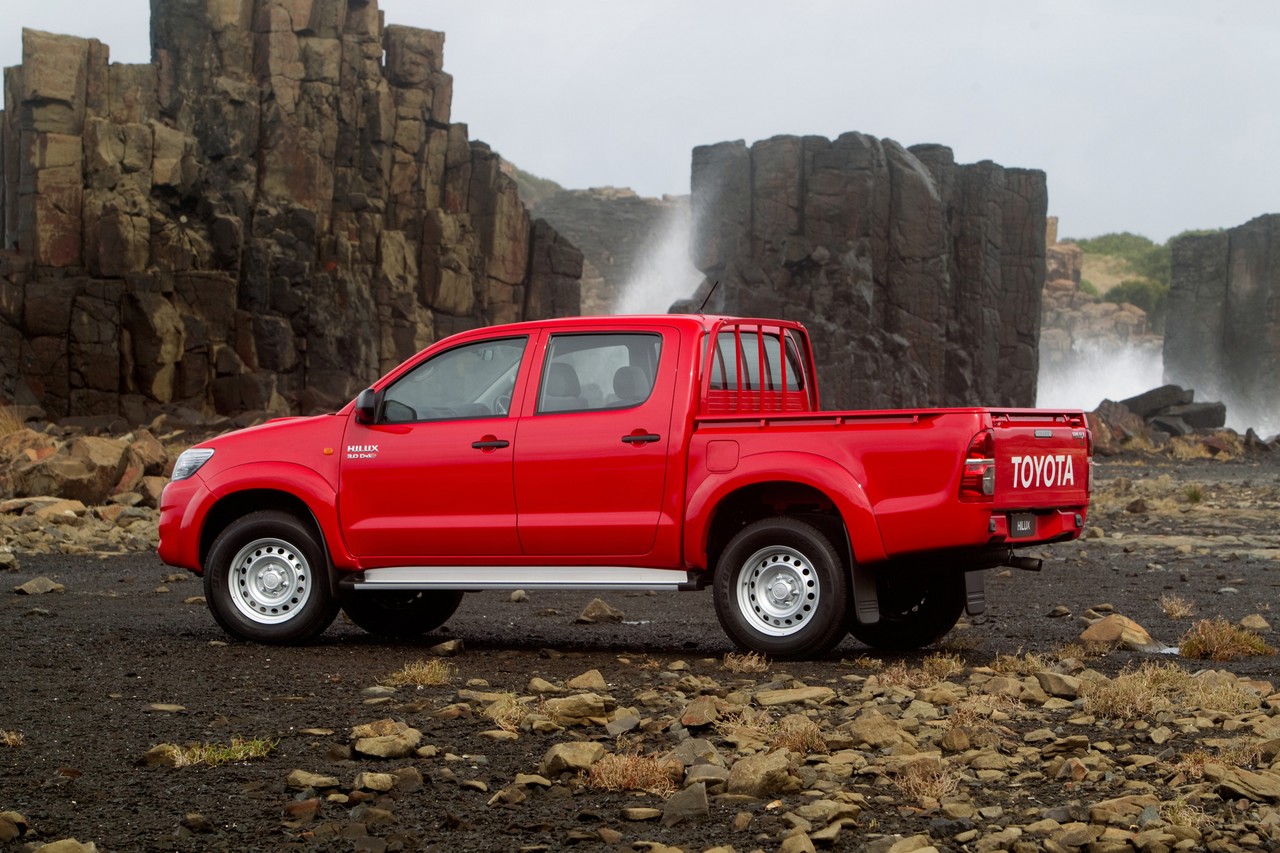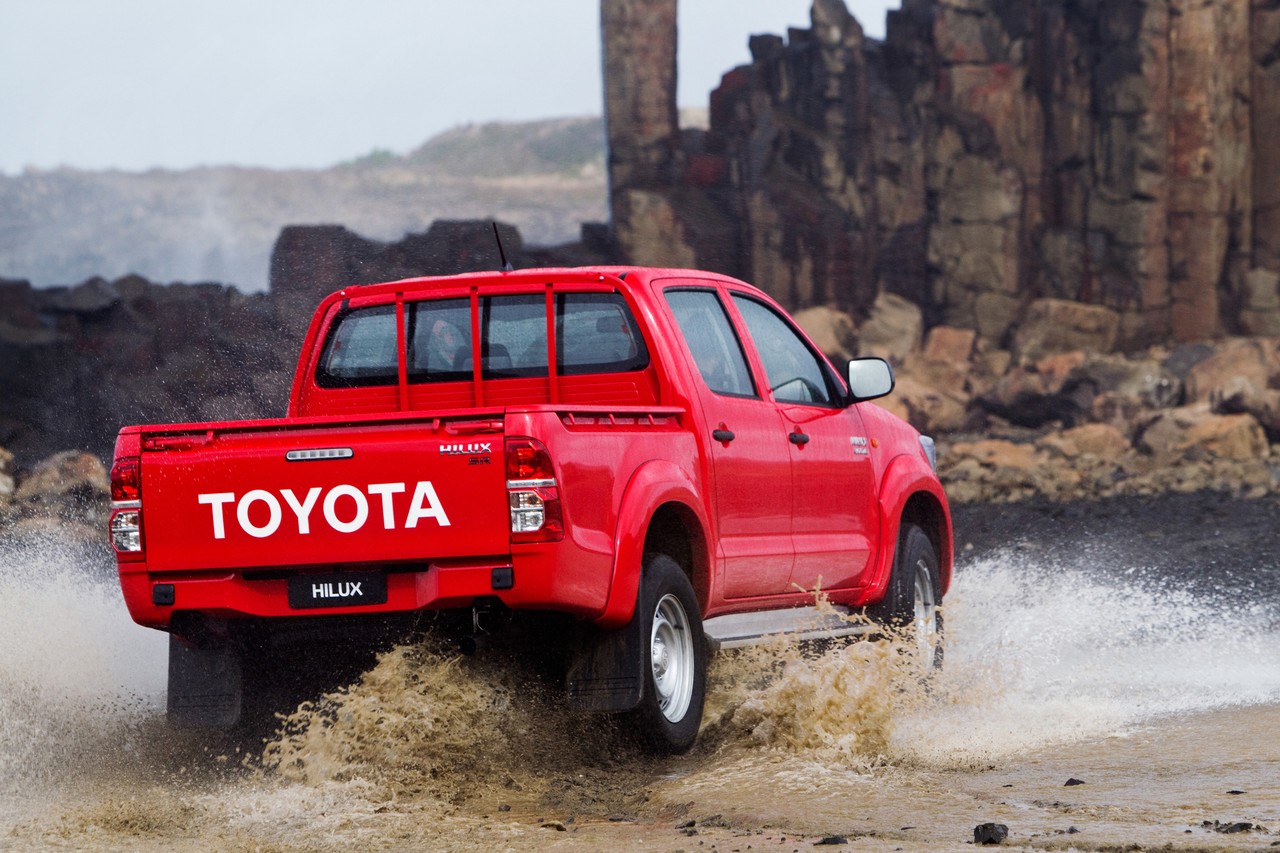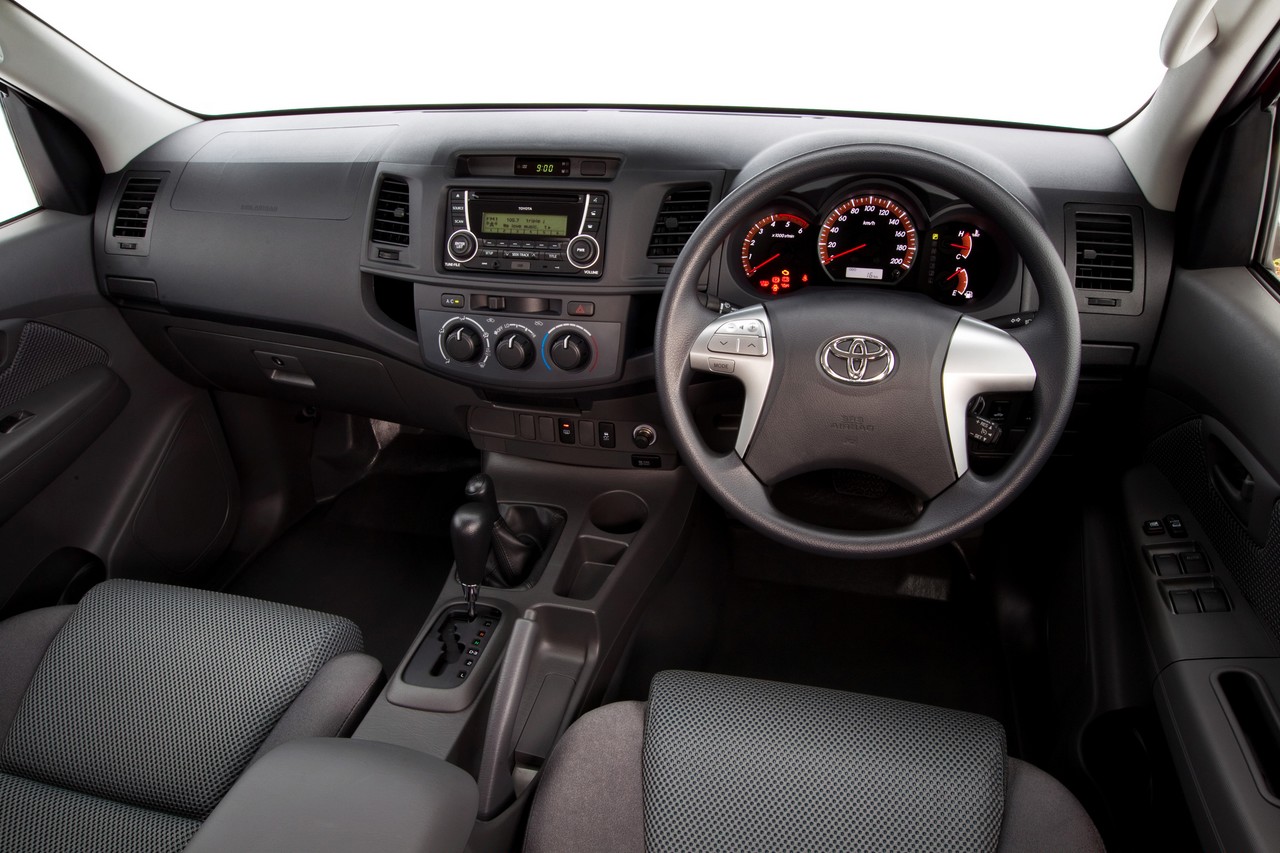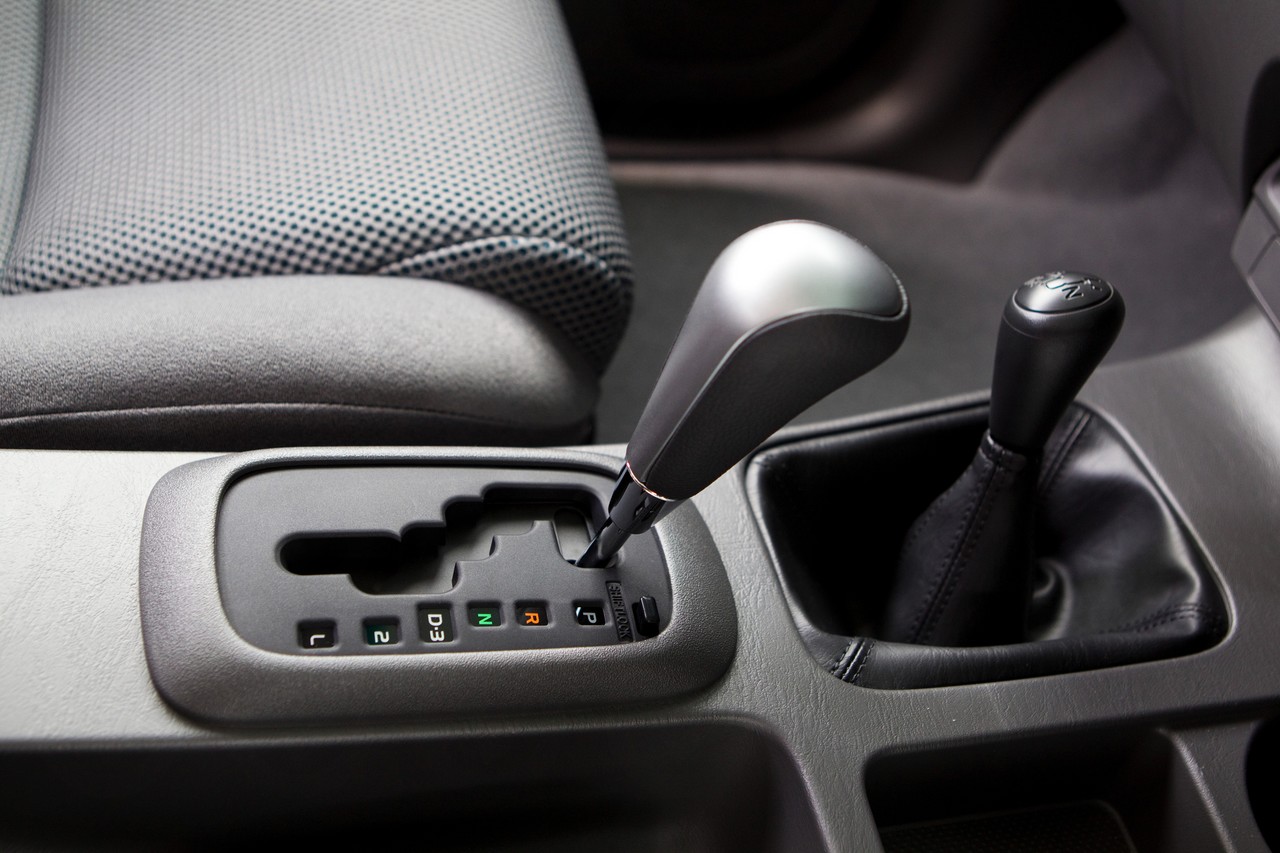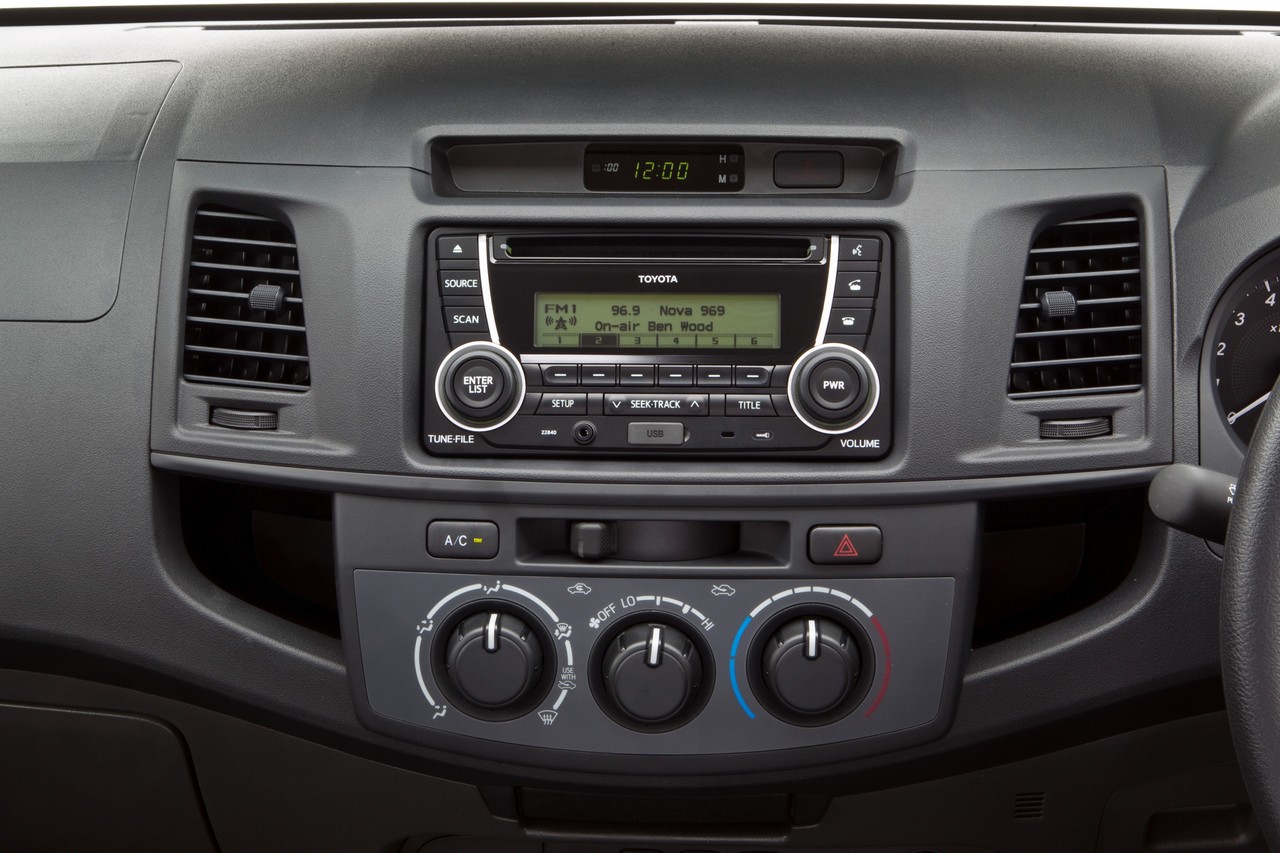
- Powerful 4.0-litre 1GR-FE V6 petrol engine
- Responsive and economical 3.0-litre 1KD-FTV turbo-diesel engine
- Comfortable ride
- Spacious cabin
- Inferior dynamics to Ford PJ Ranger and Mazda Mk.1 BT-50
- Inferior ride comfort to VW 2H Amarok
- Driver’s seat lacks support
- Noise from turbo-diesel engines
Review: Toyota Mk.7-I Hilux utility (2005-08)
Overview
Released in April 2005, the Toyota Mark 7 Series I (Mk.7-I) Hilux utility was available in single cab, extended single cab (Extra) and dual cab bodies. Manufactured in Thailand, the Hilux was available with 2.7-litre petrol, 4.0-litre petrol and 3.0-litre turbo-diesel engines.
As per the tables below, the Hilux was available in entry-level Workmate, mid-range SR and range-topping SR5 variants. Furthermore, the Mk.7 Hilux had power-assisted rack and pinion steering, double wishbone front suspension and a leaf-spring type rigid rear axle.
Engines
Of these engines,
- The 2.7-litre 2TR-FE four-cylinder petrol engine had double overhead camshafts, four valves per cylinder, variable intake valve timing (VVT-i), twin counter-rotating balance shafts, torsional rubber damper in the crankshaft pulley, electronic throttle control and a compression ratio of 9.6:1;
- The 4.0-litre 1GR-FE V6 petrol engine had an alloy block and cylinder head, double overhead camshafts (per cylinder bank, chain-driven), four valves per cylinder, variable intake valve timing (VVT-i), two-stage Acoustic Control Induction System (ACIS), electronic throttle control and a compression ratio of 10.0:1; and,
- The 3.0-litre 1KD-FTV diesel V6 engine had a cast iron block and alloy cylinder head, a variable geometry turbocharger, intercooler, double overhead camshafts, electronic direct injection, twin counter-rotating balance shafts, electronic throttle control, exhaust gas recirculation and a compression ratio of 17.9:1.
| Single cab | Extra cab | Double cab | ||||||
|---|---|---|---|---|---|---|---|---|
| Variant | SR 4×2 |
SR 4×2 |
SR5 4×2 |
SR5 4×4 |
Workmate, SR 4×2 |
SR4 4×2 |
SR 4×4 |
SR5 4×4 |
| Length (mm) | 5130 | 5130 | 5255 | 5255 | 5130 | 5255 | 5130 | 5255 |
| Width (mm) | 1760 | 1760 | 1760 | 1835 | 1760 | 1760 | 1760 | 1835 |
| Height (mm) | 1680 | 1680 | 1680 | 1795 | 1695 | 1695 | 1810 | 1810 |
| Wheelbase (mm) | 3085 | 3085 | 3085 | 3085 | 3085 | 3085 | 3085 | 3085 |
| Ground clearance (mm) | 177 | 177 | 177 | 210 | 177 | 177 | 210 | 210 |
| Approach angle | 21° | 21° | 21° | 30° | 21° | 21° | 30° | 30° |
| Tray length (mm) | 2315 | 1805 | 1805 | 1805 | 1520 | 1520 | 1520 | 1520 |
| Tray width (mm) | 450 | 450 | 450 | 450 | 450 | 450 | 450 | 450 |
| Tray height (mm) | 450 | 450 | 450 | 450 | 450 | 450 | 450 | 450 |
| Braked towing capacity (kg) | 2250 | 2250 | 2250 | 2250 | 2250 | 2250 | 2250 | 2250 |
| Cab | Variant | Engine | Drive | Trans. | Peak power | Peak torque |
|---|---|---|---|---|---|---|
| Single cab | SR | 4.0-litre petrol V6 (1GR-FE) | RWD | 5sp auto | 175 kW at 5200 rpm | 376 Nm at 3800 rpm |
| 5sp man. | 343 Nm at 2400-4800 rpm | |||||
| Extended cab (‘Xtra’) | SR | 4.0-litre petrol V6 (1GR-FE) | RWD | 5sp auto | 175 kW at 5200 rpm | 376 Nm at 3800 rpm |
| SR5 | 4.0-litre petrol V6 (1GR-FE) | RWD | 5sp auto | 175 kW at 5200 rpm | 376 Nm at 3800 rpm | |
| 4WD | 5sp man. | 175 kW at 5200 rpm | 343 Nm at 2400-4800 rpm | |||
| SR5 | 3.0-litre turbo-diesel I4 (1KD-FTV) | 4WD | 5sp man. | 120 kW at 3400 rpm | 343 Nm at 1400-3200 rpm | |
| Dual cab | Workmate | 2.7-litre petrol I4 (2TR-FE) | RWD | 5sp man. | 118 kW at 5200 rpm | 241 Nm at 3800 rpm |
| SR | 3.0-litre turbo-diesel I4 (1KD-FTV) | RWD | 5sp man. | 120 kW at 3400 rpm | 343 Nm at 1400-3200 rpm | |
| 4WD | 4sp auto, 5sp man. |
|||||
| SR5 | 3.0-litre turbo-diesel I4 (1KD-FTV) | 4WD | 4sp auto, 5sp man. |
120 kW at 3400 rpm | 343 Nm at 1400-3200 rpm | |
| 4.0-litre petrol V6 (1GR-FE) | RWD, 4WD | 5sp auto | 175 kW at 5200 rpm | 376 Nm at 3800 rpm | ||
| 5sp man. | 175 kW at 5200 rpm | 343 Nm at 2400-4800 rpm |
Safety equipment
Standard safety equipment for the Mk.7 Hilux included dual front airbags and front seatbelts with pretensioners and load limiters. The SR5 was further equipped with ABS as standard, though this was optional on the SR (and optional on the Workmate from September 2006).
ANCAP crash testing
In ANCAP crash testing, a rear-wheel drive (4×2) Hilux Workmate single cab chassis – fitted with a 2.7-litre petrol engine – received a four star adult occupant protection rating with a score of 27.31 out of 37. In the offset crash test, protection from serious leg injury was marginal for the driver; there was also a moderate risk of serious chest injury for the front passenger and a slight risk for the driver. A default score was given in the side impact test.
A four-wheel drive (4×4) Hilux SR double cab utility – fitted with a 3.0-litre turbo-diesel engine – received a four star adult occupant protection rating with a score of 26.86 out of 37. In the offset crash test, protection from serious chest and leg injury was marginal for the driver. A default score was given in the side impact test.
Features: Hilux Workmate, SR and SR5
Standard features for the Hilux Workmate included 14-inch steel wheels with 195 R14 tyres, a two speaker sound system with an AM/FM radio and a single-disc CD player, vinyl seat trim, a tilt adjustable steering column, lockable glovebox and an immobiliser. Single cab models also had a durable vinyl floor covering.
The Hilux SR was further equipped with an MP3-compatible CD player, cloth facing seat trim, remote central locking, power windows and an illuminated ignition switch; Extra Cab models were also fitted with a rear window demister. For the SR, 4×2 models had 15-inch steel wheels with 205/70 R15 tyres while 4×4 models had 16-inch steel wheels with 205/70 R16 tyres.
From September 2007, the Hilux SR also featured power mirrors and, for models with automatic transmissions, cruise control.
The Hilux SR5 was distinguished by its 15-inch alloy wheels, four speaker sound system with a six-disc MP3-compatible CD changer, air conditioning, full cloth seat trim, leather-wrapped steering wheel, power mirrors, height adjustable driver’s seat, 12 volt power socket, Optitron instrumentation and trip computer; models with automatic transmissions also had cruise control. Visually, the SR5 could be identified by its body-coloured front bumper, body-coloured radiator grille, alloy sports bar, chrome door handles and mirrors, and chrome step-type rear bumper.
From September 2006, all SR5 variants were fitted with front fog lamps, while the deck guard frame was removed; SR5 dual cab models were also fitted with a limited slip differential.
Specifications
Related links
- Press Kit: Toyota Mk.7-I Hilux (March 2005)
- Press Release: Toyota Mk.7-I Hilux – engine, safety upgrades (September 2006)
- Press Release: Toyota Mk.7-I Hilux upgrades (September 2007)
Review: Toyota Mk.7-II Hilux utility (2008-11)
Overview
Released in October 2008, the Mark 7 Series II (Mk.7-II) utility Hilux introduced a revised line-up, Euro IV emissions compliance for petrol engines and minor cosmetic changes. As part of the update, an automatic transmission was introduced for Workmate variants.
Visually, the Mk.7-II Hilux could be identified by its new front bumper, trapezoidal grille and headlights with clear indicators. Inside, there was a front passenger vanity mirror, new switchgear and, for manual models, a raised shift console.
Other changes for the Mk.7-II Hilux included revised front suspension and, for the rear suspension, double-row, roller-type axle bearings for improved reliability and stable handling. The rear suspension for the 4×2 models also received revised rear suspension bushes.
| Cab | Variant | Engine | Drive | Trans. | Peak power | Peak torque |
|---|---|---|---|---|---|---|
| Single cab | SR | 4.0-litre petrol V6 (1GR-FE) | RWD | 5sp man. | 175 kW at 5200 rpm | 343 Nm at 2400-4800 rpm |
| 5sp auto | 175 kW at 5200 rpm | 376 Nm at 3800 rpm | ||||
| Extended cab (‘Xtra’) | SR | 4.0-litre petrol V6 (1GR-FE) | RWD | 5sp auto | 175 kW at 5200 rpm | 376 Nm at 3800 rpm |
| SR5 | 3.0-litre turbo-diesel I4 (1KD-FTV) | 4WD | 5sp man. | 126 kW at 3600 rpm | 343 Nm at 1400-3400 rpm | |
| 4.0-litre petrol V6 (1GR-FE) | RWD | 5sp auto | 175 kW at 5200 rpm | 376 Nm at 3800 rpm | ||
| 4WD | 5sp man. | 175 kW at 5200 rpm | 343 Nm at 2400-4800 rpm | |||
| Dual cab | Work-mate | 2.7-litre petrol I4 (2TR-FE) | RWD | 4sp auto, 5sp man. |
116 kW at 5200 rpm | 240 Nm at 3800 rpm |
| SR | 3.0-litre turbo-diesel I4 (1KD-FTV) | RWD | 5sp man. | 126 kW at 3600 rpm | 343 Nm at 1400-3400 rpm | |
| 4WD | 4sp auto, 5sp man. |
|||||
| 4.0-litre petrol V6 (1GR-FE) | RWD, 4WD |
5sp man. | 175 kW at 5200 rpm | 343 Nm at 2400-4800 rpm | ||
| 5sp auto | 175 kW at 5200 rpm | 376 Nm at 3800 rpm | ||||
| SR5 | 3.0-litre turbo-diesel I4 (1KD-FTV) | 4WD | 4sp auto, 5sp man. |
126 kW at 3600 rpm | 343 Nm at 1400-3400 rpm | |
| 4.0-litre petrol V6 (1GR-FE) | RWD, 4WD |
5sp man. | 175 kW at 5200 rpm | 343 Nm at 2400-4800 rpm | ||
| 5sp auto | 175 kW at 5200 rpm | 376 Nm at 3800 rpm |
Features
Compared to its Mk.7-I predecessor, standard features were largely unchanged. Workmate variants, however, were fitted with 15-inch steel wheels and, as a result, larger 275 mm diameter ventilated front brake discs (previously 255 mm).
October 2009: Hilux update
In October 2009, the Mk.7-II Hilux was updated. As part of the update, standard safety equipment for dual cab SR5 4WD models was extended to include front seat-mounted side airbags and curtain airbags.
The Hilux Workmate and SR received upgraded audio systems with a USB input and Bluetooth mobile telephone compatibility; beyond this, the SR received a four-spoke steering wheel with audio controls.
Standard features for the Hilux SR5 were extended with an upgraded audio system that included a colour LCD screen, USB input and Bluetooth mobile telephone compatibility, sports-style front seats and cruise control (previously limited to models with automatic transmissions); double cab models also received rear privacy glass.
October 2010 Hilux update
There was another minor update in October 2010 as SR5 dual cab models fitted with the 3.0-litre turbo-diesel engine were equipped with electronic stability control, traction control, brake assist and electronic brake force distribution; 17-inch alloy wheels were also added.
Related links
- Press Release: Toyota Mk.7-II Hilux (October 2008)
- Press Release: Toyota Mk.7-II Hilux update (October 2009)
- Press Release: Toyota Mk.7-II Hilux utility SR5 – safety upgrades (October 2010)
Review: Toyota Mk.7-III Hilux utility (2011-15)
Overview
Released in September 2011, the Toyota Mark 7 Series III (Mk.7-III) Hilux utility introduced an expanded range, revised suspension and increased braked towing capacity for four-wheel drive models (2.5 tonnes subject to regulatory requirements, towbar design, vehicle design and towing equipment limitations). The expanded range – given in the table, below – included four-wheel drive Workmate variants and additional turbo-diesel models. Visually, the Mk.7-III Hilux could be identified by its new front bonnet, three-bar grille, bumper, twin-element wrap-around headlights and clear tail-light lenses.
November 2013 and January 2014 Hilux updates
Updates for Single Cab and Extra Cab models were introduced in November 2013, with these updates also applied to Dual Cab models from January 2014. As part of the update, a five-speed automatic transmission was introduced for the 3.0-litre turbo-diesel engine.
Inside, the updated models had new 6.1-inch display audio systems, interior colours and materials; while Extra Cab models had a black interior, Single Cab models had black-and-grey tones. Furthermore, SR and SR5 variants received Optitron instrumentation.
| Cab | Variant | Engine | Drive | Trans. | Peak power | Peak torque |
|---|---|---|---|---|---|---|
| Single cab | SR | 4.0-litre petrol V6 (1GR-FE) | RWD | 5sp man. | 175 kW at 5200 rpm | 343 Nm at 2400 rpm |
| 5sp auto | 175 kW at 5200 rpm | 376 Nm at 3800 rpm | ||||
| Extended cab (‘Extra’) | SR | 3.0-litre turbo-diesel I4 (1KD-FTV) | RWD, 4WD |
5sp man. | 126 kW at 3600 rpm | 343 Nm at 1400 rpm |
| 4.0-litre petrol V6 (1GR-FE) | RWD | 5sp auto | 175 kW at 5200 rpm | 376 Nm at 3800 rpm | ||
| SR5 | 4.0-litre petrol V6 (1GR-FE) | RWD | 5sp auto | 175 kW at 5200 rpm | 376 Nm at 3800 rpm | |
| 3.0-litre turbo-diesel I4 | 4WD | 5sp man. | 126 kW at 3600 rpm | 343 Nm at 1400 rpm | ||
| Double cab | Workmate | 2.7-litre petrol I4 (2TR-FE) | RWD | 5sp man., 4sp auto |
116 kW at 5200 rpm | 240 Nm at 3800 rpm |
| 3.0-litre turbo-diesel I4 (1KD-FTV) | 4WD | 5sp man., 4sp auto, 5sp auto (2013-15) |
126 kW at 3600 rpm | 343 Nm at 1400 rpm | ||
| SR | 3.0-litre turbo-diesel I4 (1KD-FTV) | RWD | 5sp man. | 126 kW at 3600 rpm | 343 Nm at 1400 rpm | |
| 4WD | 5sp man., 4sp auto, 5sp auto (2013-15) |
|||||
| 4.0-litre petrol V6 (1GR-FE) | RWD, 4WD |
5sp man. | 175 kW at 5200 rpm | 343 Nm at 2400 rpm | ||
| 5sp auto | 175 kW at 5200 rpm | 376 Nm at 3800 rpm | ||||
| SR5 | 4.0-litre petrol V6 (1GR-FE) | RWD | 5sp auto | 175 kW at 5200 rpm | 376 Nm at 3800 rpm | |
| 4WD | 5sp man. | 175 kW at 5200 rpm | 343 Nm at 2400 rpm | |||
| 5sp auto | 175 kW at 5200 rpm | 376 Nm at 3800 rpm | ||||
| 3.0-litre turbo-diesel I4 (1KD-FTV) | 4WD | 5sp man, 4sp auto, 5sp auto (2013-15) |
126 kW at 3600 rpm | 343 Nm at 1400 rpm |
Safety equipment
Compared to its Mk.7-II predecessor, ABS made standard across the range such that standard safety equipment consisted of dual front airbags, ABS and front seatbelts with pretensioners and load limiters.
As part of the Mk.7-III update, dual cab SR5 four-wheel drive models with the 4.0-litre petrol engine gained electronic stability control, traction control, electronic brake force distribution and brake assist (previously limited to dual cab SR5 four-wheel drive models with turbo-diesel engines).
From November 2013 for four-wheel drive Single Cab and Extra Cab models, standard safety equipment was extended to include electronic brake force distribution, brake assist, electronic stability control, traction control and a front passenger seat-belt reminder. Four-wheel drive Dual Cab models were also fitted with these safety technologies from January 2014.
ANCAP crash testing
ANCAP awarded post-November 2013 four-wheel Single Cab and Extra Cab models, and post-January 2014 four-wheel drive Dual Cab models five star adult occupant protection ratings with a score of 32.86 out of 37.
Features: Hilux Workmate, SR and SR5
Standard features for the Mk.7-III Hilux Workmate included 15-inch steel wheels, a two speaker sound system with an AM/FM radio, an MP3-compatibile CD player and Bluetooth mobile phone connectivity, vinyl seat trim, a tilt adjustable steering column, lockable glovebox and an immobiliser. Single cab models also had a durable vinyl floor covering.
The Hilux SR was further equipped with cloth facing seat trim, cruise control, remote central locking, power windows and mirrors, four-spoke steering wheel with audio controls and an illuminated ignition switch. Furthermore, SR variants with the 4.0-litre V6 petrol engine were also fitted with sports seats and a limited slip rear differential.
The Hilux SR5 was distinguished by its alloy wheels, six speaker sound system with a six-disc MP3-compatible CD changer and USB input, satellite navigation with a 6.1-inch display, air conditioning, sports-style front seats, front fog lights, automatic headlights, a leather-wrapped steering wheel, 12 volt power socket, Optitron instrumentation and trip computer; dual cab models were also fitted with rear privacy glass and a limited slip rear differential.
Features: November 2013 and January 2014 updates
From November 2013 for Single Cabs and Extra Cabs, and from January 2014 for Dual Cabs, standard features were extended to include a new audio system with a 6.1-inch display, auxiliary inputs (3.5 mm/USB/iPod) and Bluetooth connectivity.
Beyond this, the Hilux SR and SR5 received telephone and voice recognition, and steering wheel controls for the trip computer (Toyota’s ‘multi-information display or MID).
The Hilux SR5 was further distinguished by its standard satellite navigation system with SUNA Live Traffic updates and reversing camera; the SR5 Extra Cab models were also fitted with 17-inch alloy wheels (previously 15-inch alloys).
2014 Hilux Black
Released in October 2014, the Hilux Black was a special edition model that was based on the Hilux SR5 4×4 Double Cab and solely available with the 3.0-litre turbo-diesel engine. Visual cues for the Hilux Black included 17-inch black-painted alloy wheels, unique front and rear bumpers, a black lower front grille with a red stripe along the bottom edge, LED daylight running lamps, black extensions below the fog light surrounds, black side steps, a sports bar and special edition badges. The Hilux Black was available in Eclipse Black and Glacier White paint finishes.
Compared to the SR5, features for the Hilux Black were extended to include leather seat trim and a six-way power adjustable driver’s seat.
Brochures
- Brochure: Toyota Mk.7-III Hilux 4×2 (February 2014)
- Brochure: Toyota Mk.7-III Hilux 4×4 (April 2014)
Related links
- Press Kit: Toyota Mk.7-III Hilux (September 2011)
- Press Release: Toyota Mk.7-III Hilux update (November 2013)
- Flyer: Toyota Mk.7-III Hilux Black (October 2014)
- Toyota Australia: Toyota Hilux
- Wikipedia.org: Toyota Mk.7 Hilux
